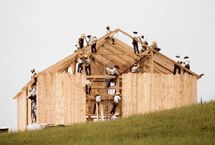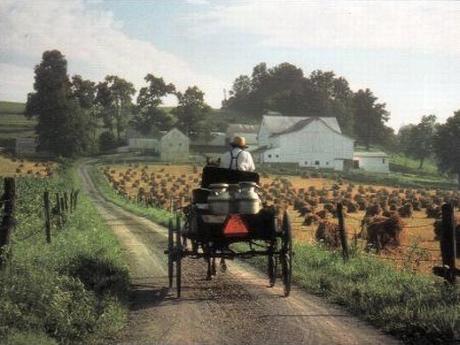A 2011 UK Channel Four Series
www.channel4.com/programmes/living-with-the-amish/
Living with the Amish follows six British teenagers leaving their mobile phones, Facebook accounts and partying behind, as they head to Ohio and Pennsylvania to see what they can learn from six weeks of hard work and simple living. No Amish (pronounced ‘Aah-Mish’) community has opened up in this way before, and the Amish families taking part in the series hope that it will reveal the advantages of a pure, uncluttered way of life.
Charlotte, 18, loves clothes and shopping, and never leaves the house without her make-up on. But Charlotte thinks there’s more to life than what you wear and wants to see if the Amish experience will help her gain confidence and independence..
Also headed for the US are Eton College student George, 17, who wants to see what life is like in a community largely hidden from the outside world; and Cambridge University undergraduate Siana, 19, who lives with her single mother, younger brother and sister on a London council estate.
Siana’s family came from Sierra Leone when she was a toddler. She wants to learn more about the Amish viewpoint and their reasons for wanting to keep their traditions alive.
Joining them are 17-year-old Christian Hannah, who wants to see if meeting such a devoutly religious group will cement her faith, or make her question it. Media studies student Jordan wants to know what it’ll be like without social media and music to occupy him 24/7.
Seventeen-year-old James also loves listening to music and spends much of his day playing computer games. Since spending the last few years of his life in foster care, James now lives alone in a hostel in London. He says he never eats fresh fruit or vegetables and prefers take-aways: something unheard of to the Amish, who grow or catch all their own food.
Now the teens swap their iPhones, clothes, jewellery and diets for the Amish way of life. The first family they stay with are Jonathan and Marietta in Middlefield, Ohio, home to 14,000 Amish folk.
Jonathan and Marietta want to show the teens how rich their lives are, despite their lack of worldly possessions. They believe that the Amish way of life has something to teach everyone, and there is so much more to being Amish than just horse-drawn buggies, beards and barn-raising.
The Amish are descendants of a group of 17th-century Anabaptists. Their name derives from their leader, Jacob Amman, who lived in Switzerland. From their study of the Bible back then, these God-fearing people recognized that infant baptism and military service were wrong. Because of their stand, the government persecuted them. A few even paid for their religious convictions with their lives. Persecution continued to increase, and a number of them were forced to flee to other parts of Switzerland and to France. From the beginning of the 18th century, thousands fled to the United States. With them, they brought their culture and the Swiss German dialect.
The second episode was all about hard work, and another great Amish tradition: barn-raising. While the boys, Jordan, George and James, learn the joys of physical labour, the girls, Charlotte, Siana and Hannah, experience a woman’s life, Amish-style.
Since arriving in America 300 years ago, hard work has been central to the Amish way of life, often working with the abundant supply of wood that surrounds them.
The teens stay with two Amish families who rely on timber for their livelihoods. Even the young must work hard, and Amish children leave education at 14 to contribute to the household by earning a wage.
The boys thrive helping with the barn-raising, as 40 traditionally-dressed Amish men raise a barn in a morning. It’s an awe-inspiring sight and a moving expression of community, which makes a big impact on all the teenagers.
Meanwhile, the girls work at preparing food for the men; something of a surprise for 21st-century British girls.
In episode three, the teens turn their hand to farming with some of the hardest working Amish around, and learn about New Order Amish courtship rules, where dating couples can’t even hold hands before they’re married.
The boys stay with Lloyd and Edna, New Order Amish who ‘love God, live plain and dress plain’. They run their dairy farm as a family operation with no hired help.
The teens are not used to chores – James has never worked and says his religion is ‘to do what I like’ – but Amish children learn responsibility at a much younger age. As soon as a child is old enough to pick up a shovel, they can work, usually around the age of eight.
For some of the teens it’s about converting to God, while others question their own attitude to sex before marriage after seeing the purity of the New Order way of life.
Episode four and the teenagers stay with the Burkholder family – members of a plain order called Horse and Buggy Mennonites. Back in the 1600s, the Amish split from the Mennonites to pursue a more austere way of life.
Although the Mennonites have modernised slightly, they’re allowed electricity and telephones, and their women wear a brighter selection of floral dresses and frilly bonnets, they share the Amish belief that a simple, Godly life is the key to contentment.
As the boys work on the family-run melon farm, the eternal ‘pursuit of happiness’ resonates with George, who begins to question his privileged, ambitious life back at home.
The girls are invited to party Mennonite-style at a weekly scrapbook frolic, but the fun doesn’t stop there; Saturday night is youth group and it’s the place to play volleyball, sing Christian songs and, if you’re lucky, meet that special someone.
All the teenagers are intrigued by the innocent dating rituals of the Old Order Mennonites, none more so than James, who takes a bit of a shine to the Burkholders’ eldest daughter Darleen, and becomes eager to find out how to make an impression, Mennonite-style.
Episode five and horses, essential to Amish life. In this episode the teenagers stay with two Amish families in Pennsylvania who still work their farms using horsepower. The teens visit a traditional Amish horse auction, and put in long, back-breaking hours helping with the harvest.
The woman of the house, Becky, teaches Charlotte and Hannah about the advantages of staying pure until married, while Siana faces difficult questions about the lack of religion in her life, and learns something about the nature of forgiveness.
In the final episode the teenagers stay with some Amish ‘rebels’ who are deciding whether or not to leave the Schwartzentruber church – the strictest and most secretive of all Amish groups. Schwartzentrubers wear the plainest clothes of all the Amish, and as well as not having electricity in their homes, they don’t have running water or indoor plumbing.
The boys camp out in the woods with some young Schwartzentruber men who are being shunned by their church for wanting to bring in a new piece of machinery for their sawmill. The problem appears to be that although the petrol powered saw may be acceptable in theory, the electrical spark plug was not. Surely a case of ‘straining out the gnat’?
The girls stay with Becky, who was brought up Schwartzentruber, but has made the momentous decision to leave. While Becky and her cousins try to negotiate a course between the Amish values they grew up with and the 21st-century America all around them, the British teenagers find that they are becoming more Amish. As the time approaches for them to return to Britain, the question is, how has the experience changed them?
Clearly, the high morals, and the strong emphasis on family and community are very admirable, but they remain facing many of the uncertainties of people everywhere. Of course, many people in the developing world at large also have to be resourceful, manage without electricity or running water, for example. The difference with the Amish is that they have chosen to maintain this lifestyle. One hopes the choice is truly an individual one, not simply determined by others.
References:
www.channel4.com/living-with-the-amish
With thanks

